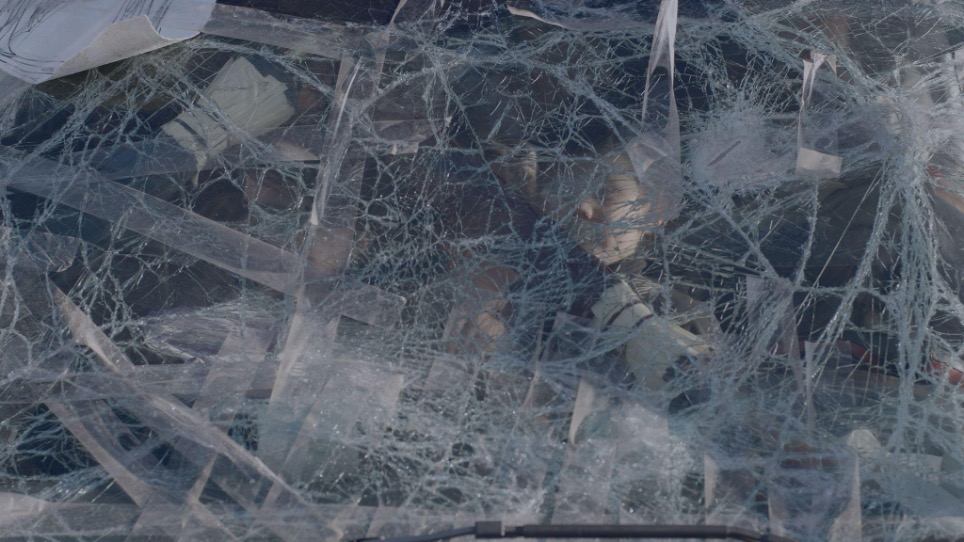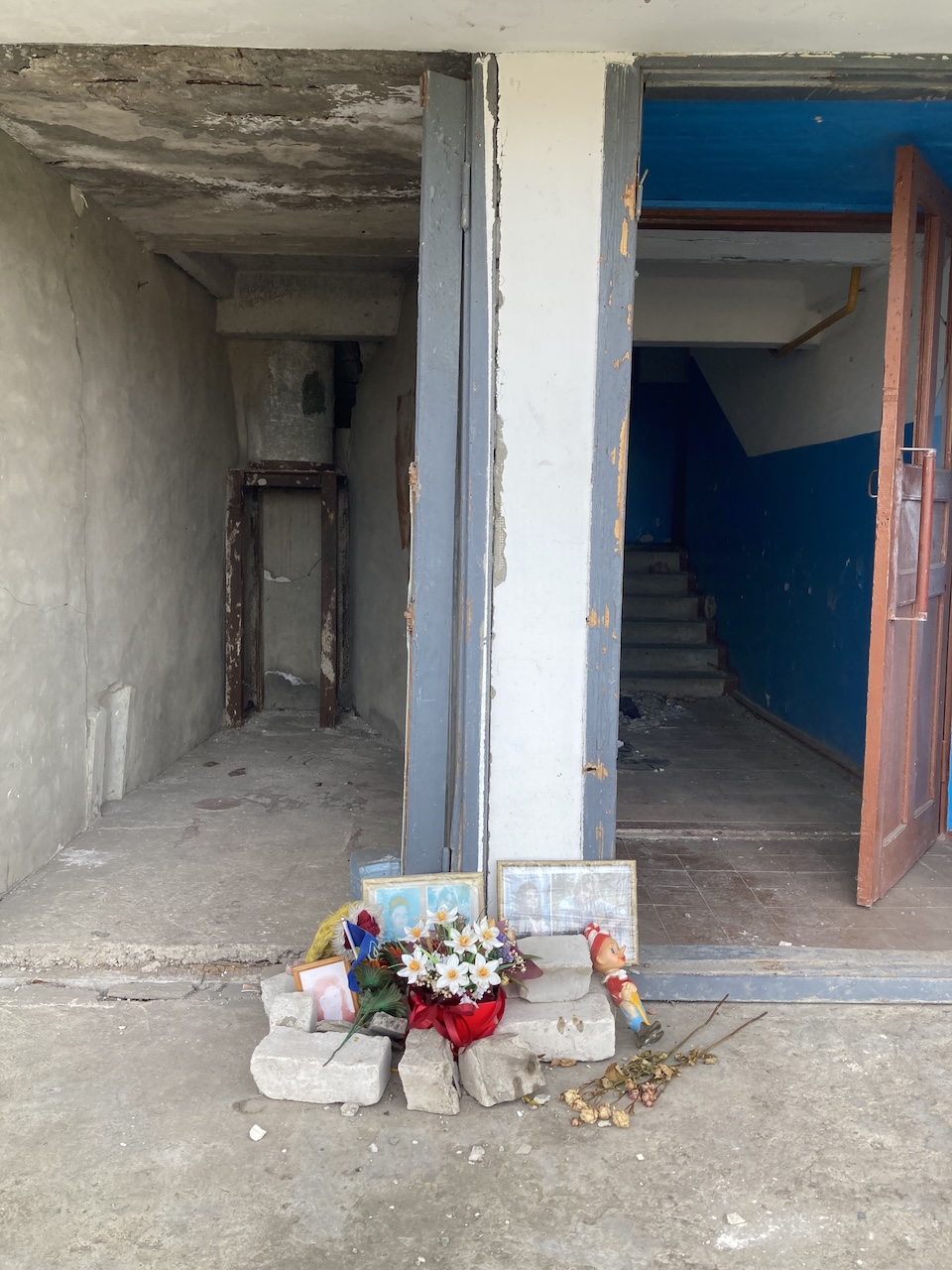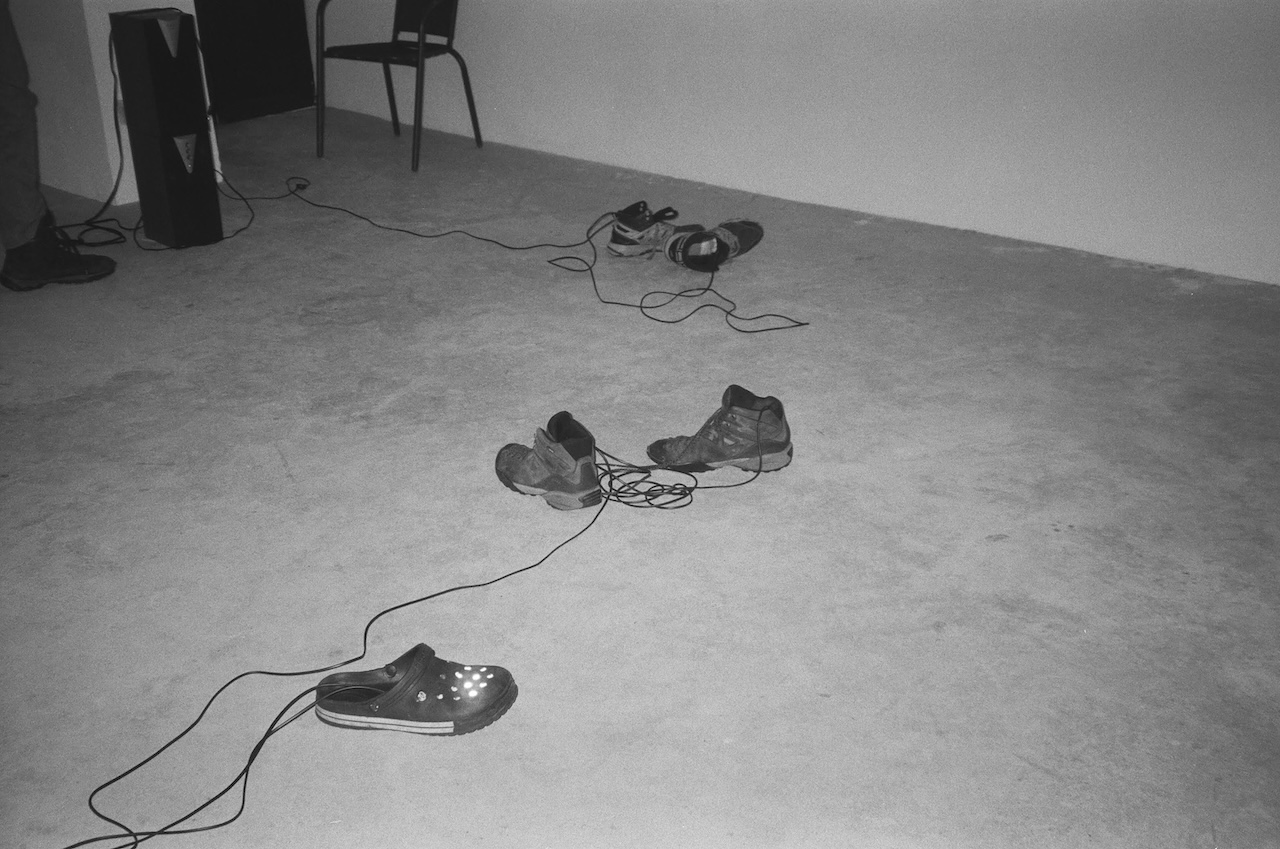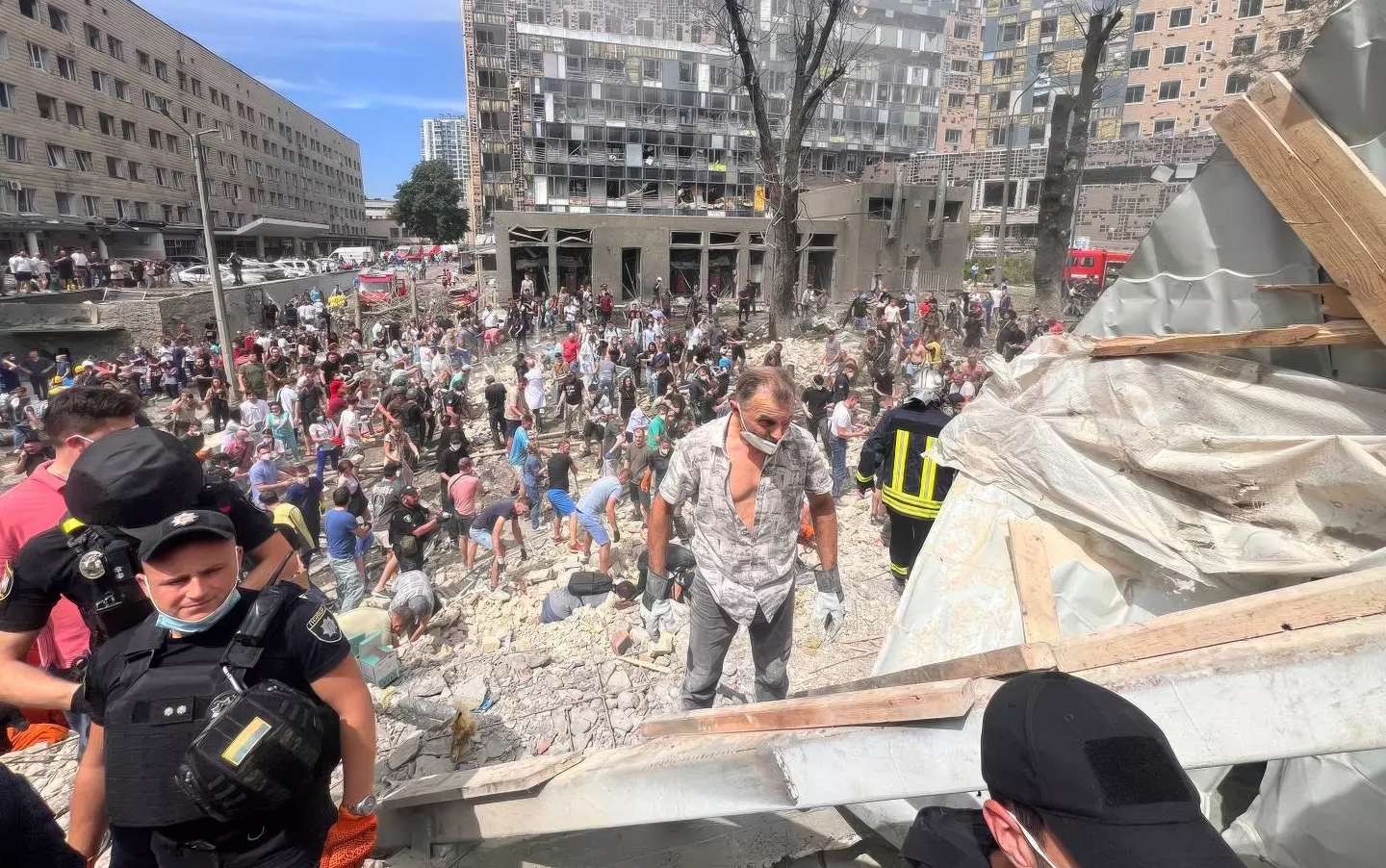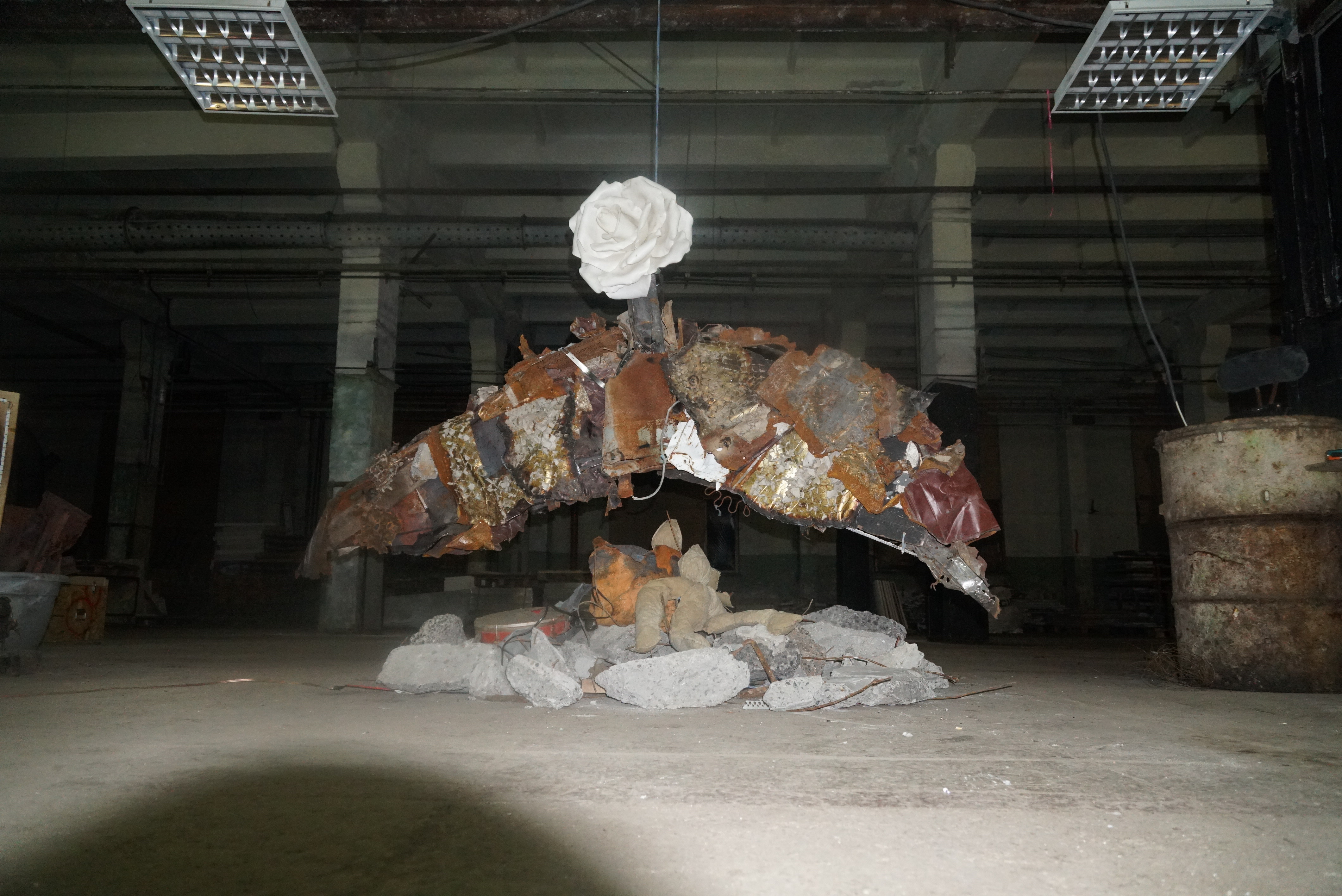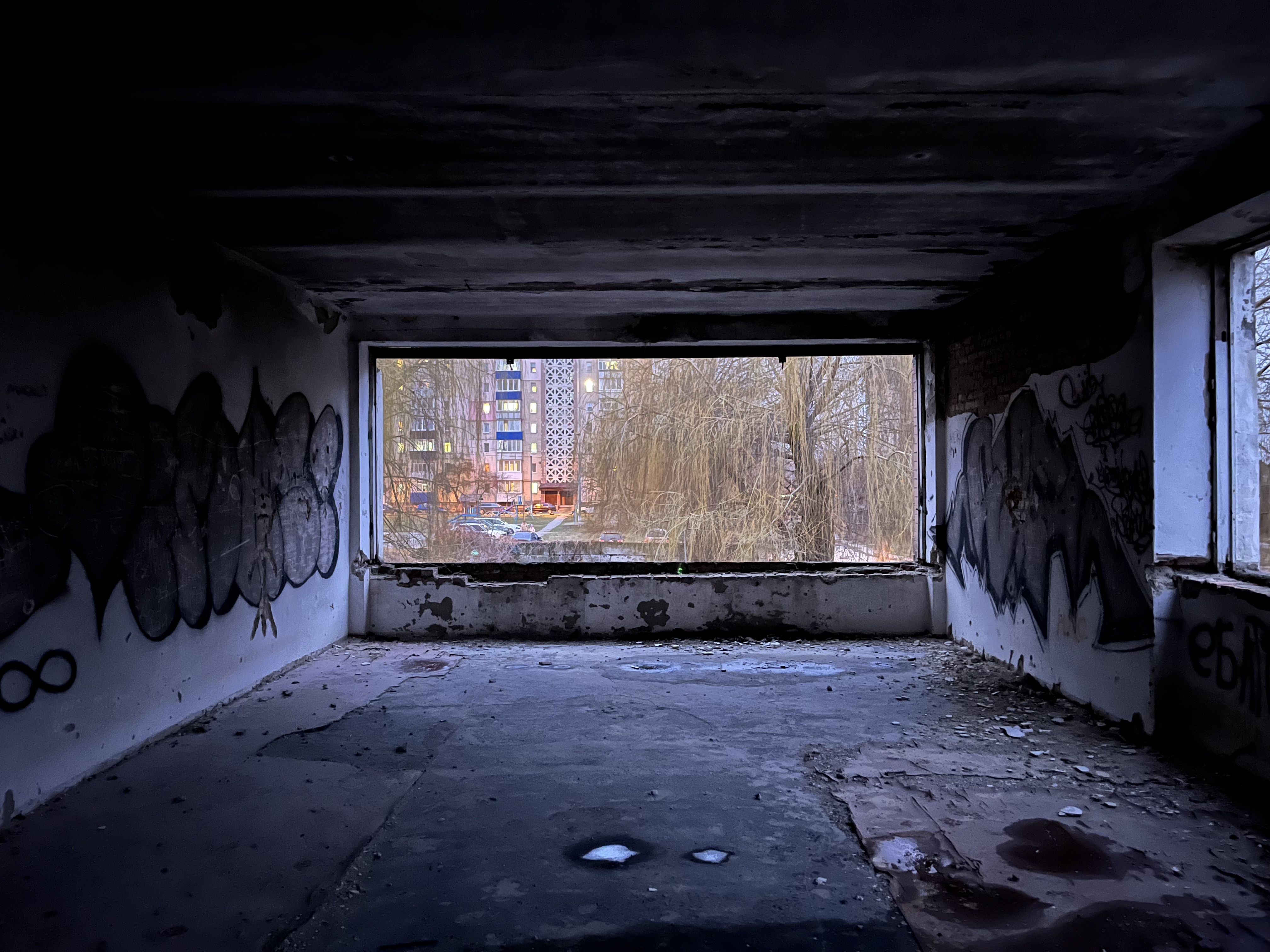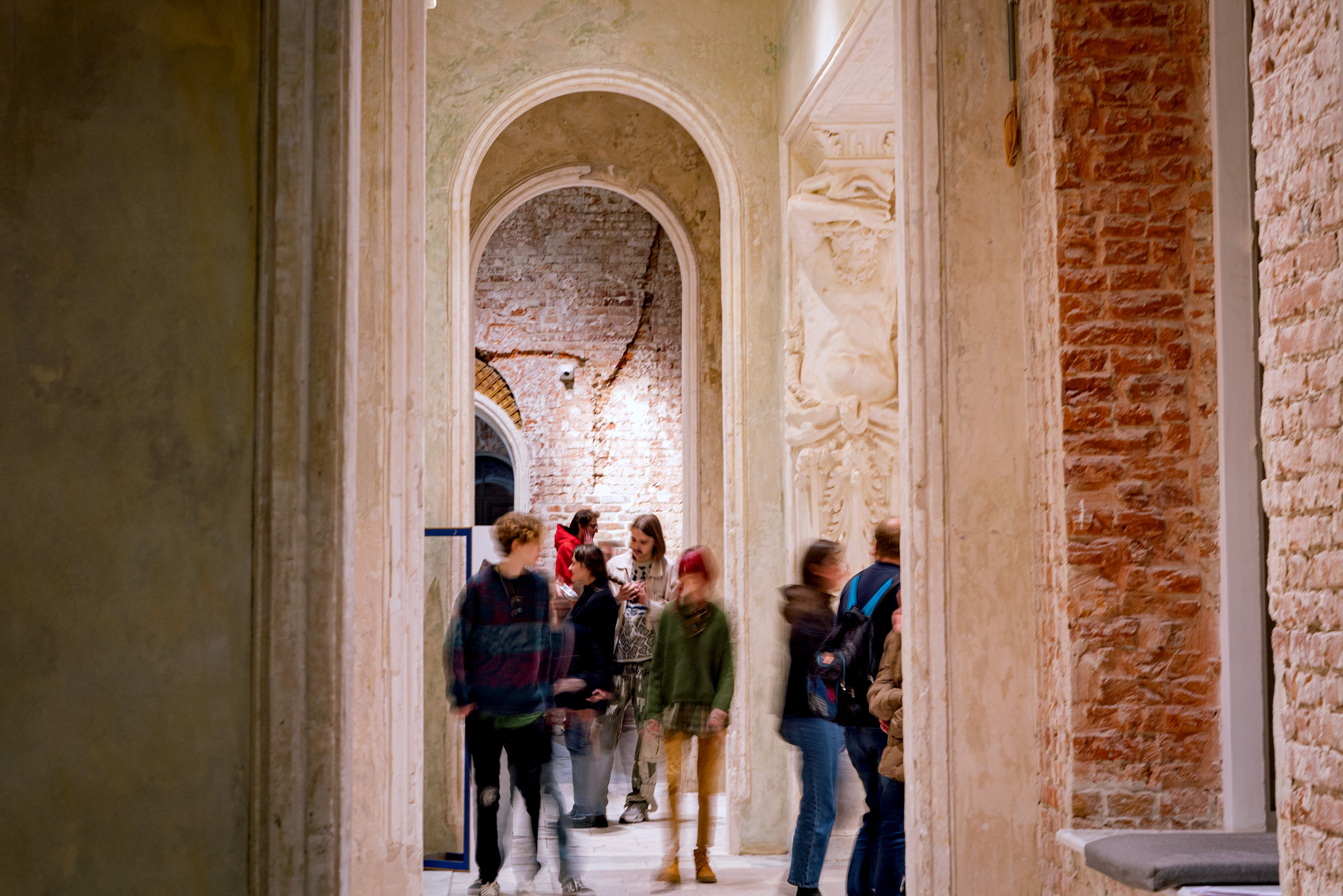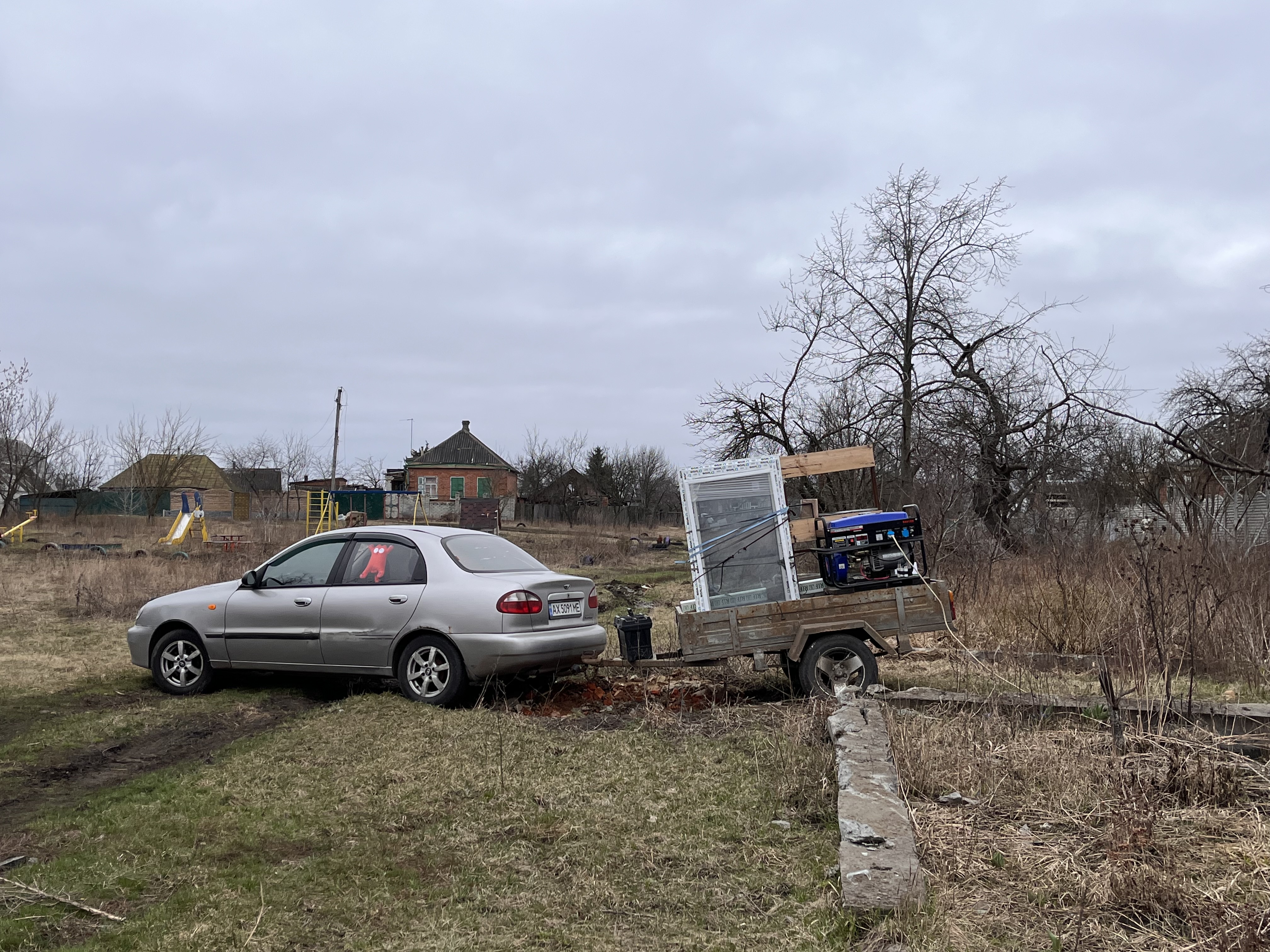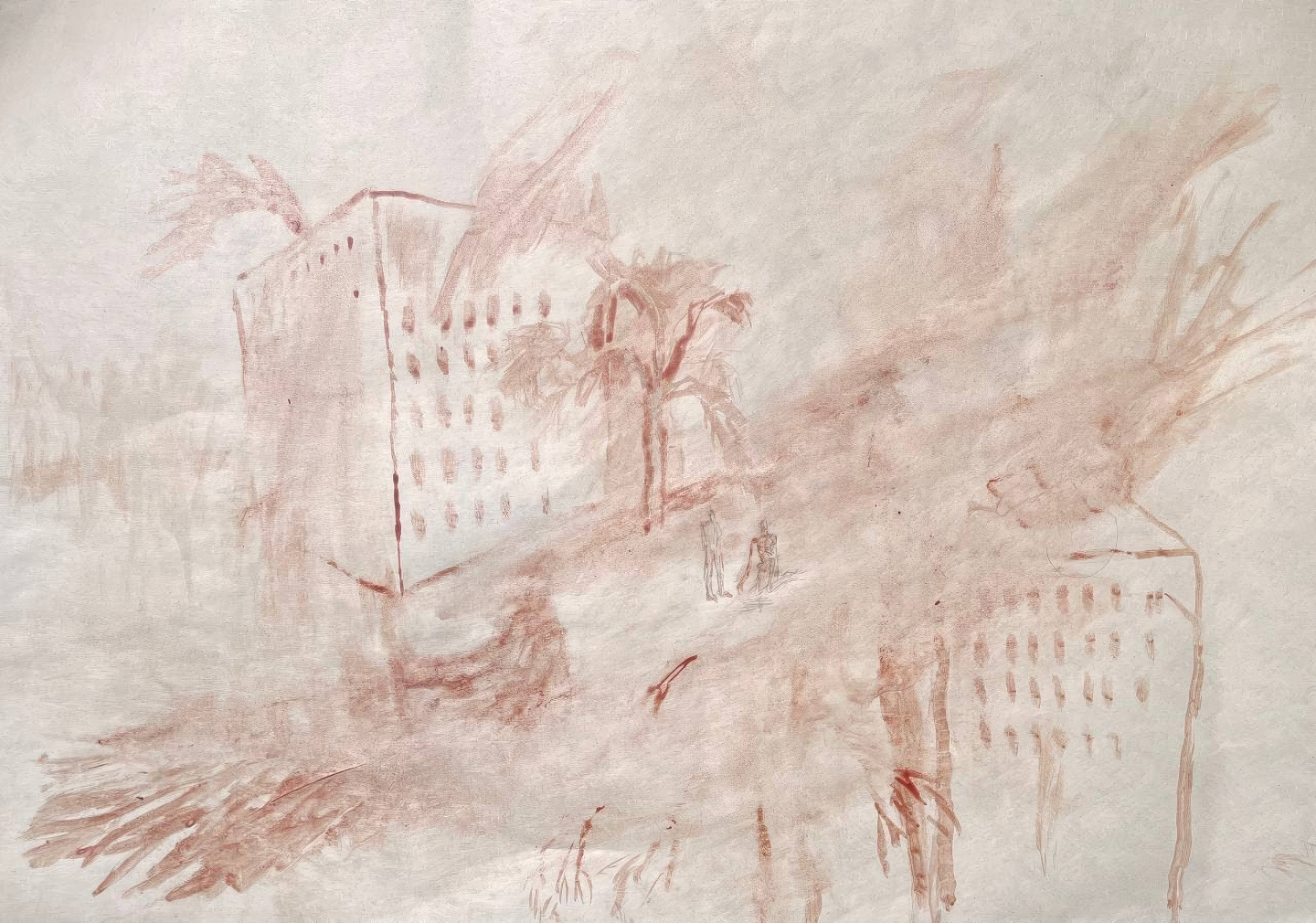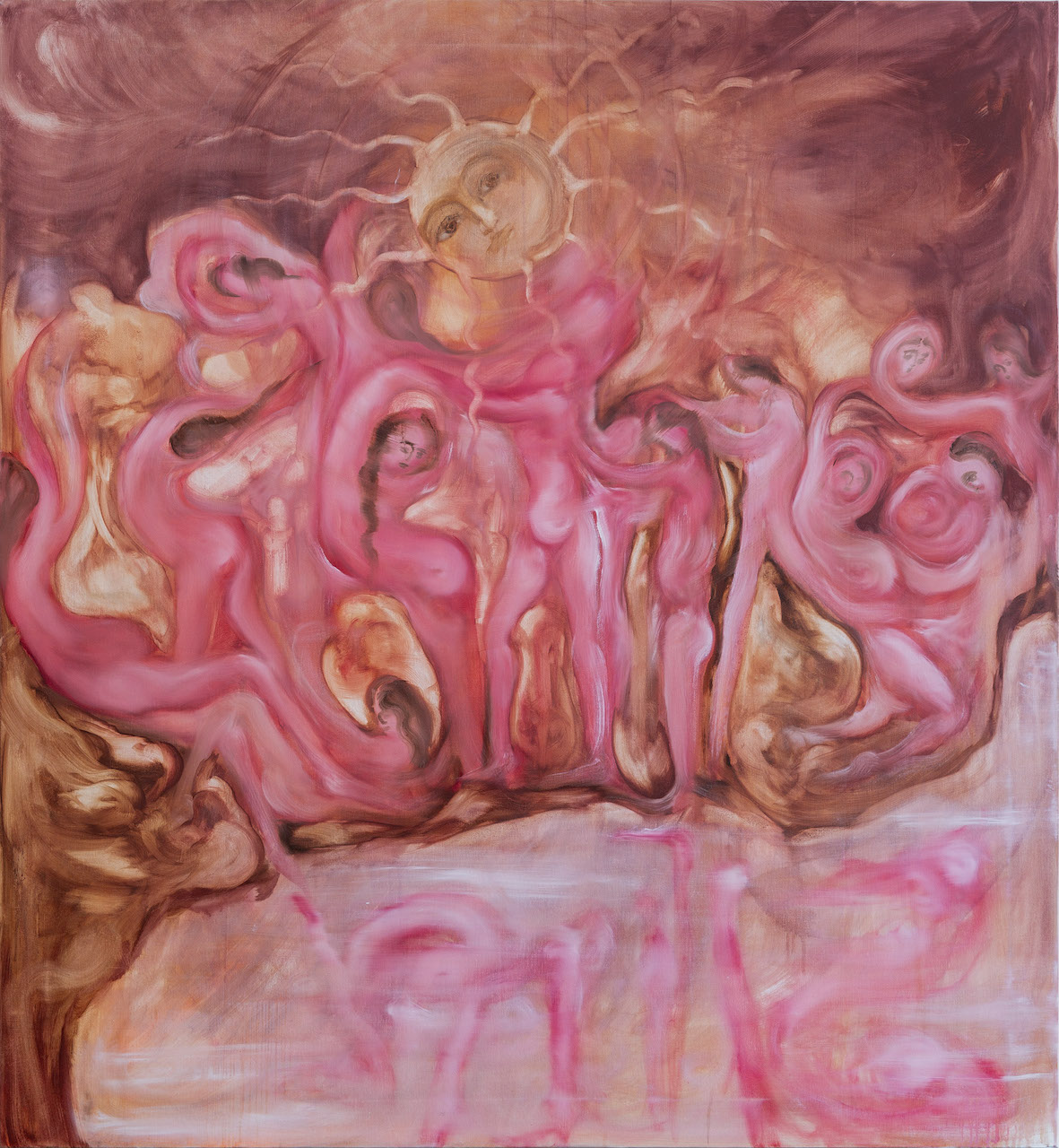
Sana Shahmuradova Tanska, Don’t touch my circles they don’t belong to you, 2023. Courtesy the artist and Gunia Nowik Gallery.
This essay was motivated by a conversation I had at an exhibition of work by a Warsaw-based Ukrainian artist, curated by a gray-haired Polish philosopher. “But this exhibition, it is not about the war!” the philosopher declared proudly, after giving me a brief tour of the show, noting how this makes the collaboration between the Polish curator and the Ukrainian artist unique, since today everything that concerns Ukrainian art has to do with war and war alone. “Those exhibitions that fill up galleries and museums all over Poland,” he continued, “are usually mildly interesting and represent nothing apart from being part of the current Ukrainian trend.” He then spoke of memory and archival fever, quoting Derrida, Foucault, and Freud. “The most important function of memory, as Freud wrote, is to forget.” “Trend”—a word to forget, as it was spoken on the day of yet another bombing that murdered civilians, and a little more than a week after the destruction of the Kakhovka Dam. But “Ukrainian trend” are words difficult to forget, precisely because of the circumstances they were spoken in, as they touch on the relation between the atrocity of war, the urgent desire for voice and visibility, the usual logic of artistic fashions, and, above all, the painful incompatibility of these realms.
As a Polish person and exhibition-goer, I have observed a growing interest in Ukrainian art in Poland over recent years, and in particular since the beginning of Russia’s full-scale invasion. Before going any further, it’s important to ask how Ukrainians are currently represented in the Polish art scene. The answer is contradictory: while they are abundantly present, their work is barely discussed outside the notion of presence alone. The exhibitions, of which a number have been staged as the war continues (I mention just a few recent examples below), are exempt from the judgement of art criticism by popular consensus, and understandably so, as their point is first and foremost about solidarity and visibility. But what is lost in the process is any critical discussion of identity, representation, and importantly, tokenism. It is not just the art scene that could benefit from such discussions, but also Poland’s multinational society. And if by now these exhibitions are accompanied by a certain fatigue, endemic to the logic of the art world—ever hungry for the next big thing—it is not because they are uninteresting outside the categories of visibility and solidarity, but because no critical or interpretative effort is being made to consider them from a more nuanced perspective.
With this in mind, I went to the Centre for Polish Sculpture in Orońskofor the tenth edition of the Young Triennial, which, like many other exhibitions of late, consists of a joint presentation of Polish and Ukrainian art practices.1 The show, addressing the invasion yet trying to transgress the category of traumatic experience, includes works by, among others, Inga Levi, Weronika Zalewska, and Dmytro Krasnyi—works that engage with issues of the commons, migration, and imperialism. But one work in particular, a video performance by Iryna Loskot, caught my attention as reflecting on its own position vis-à-vis questions of nationality and representation. The artist, dressed as a cheerleader with blue and yellow pom-poms made of trash bags, dances and sings against a background of archival footage of a Ukrainian national celebration, referring to her school memories of being forced to sing patriotic songs. The artist decided to reenact this uncomfortable childhood experience, thereby drawing a parallel between performing nationalism at school in her youth and performing it at Ukraine-themed exhibitions now.
In his seminal essay “Black Art and the Burden of Representation,” Kobena Mercer commented on how Black British artists in the 1990s, positioned at the margins of the institutional spaces, were burdened with the impossible role of “representatives” accountable to, and speaking on behalf of, the communities they came from. Those deprived of a voice who finally do get to speak, Mercer writes, are expected not only to be representatives but are also pressured to say everything all at once: “If there is only one opportunity to make your voice heard, is it not the case that there will be an intolerable imperative to try and say everything there is to be said, all in one mouthful?”2 In today’s Poland, many Ukrainian artists (and to some extent also Belarusian artists, but that is a separate story) face related challenges. What often comes with getting the space to speak is the expectation of being representatives of their nation in times of national urgency, according to the fixed categories of victim and refugee. It’s these categories that artists find ways to subvert, despite the most unimaginable circumstances—the ongoing genocide.
I was reminded of Mercer’s text as I walked through the rooms of HOS Gallery in Warsaw, looking at “Blakytna Trojanda,” a group show displaying art and activism by queer Ukrainian artists.3 Along with textile sculptures by Jan Bačynsjkyj, which recalled both religious iconography and misfit bodies, and a call to “Arm Ukrainian Queers” spray-painted on the wall, the show included a collection of white envelopes with a touch of blue that concealed intimate letters written by Olexii Kuchanskyi. The transition between what has collapsed since February 24, 2022, Kuchanskyi writes, and “the inevitably emerging environment of life seems to be repressed by the limitations of binary divisions of the militarized imaginary.” In this imaginary, the individual has to be “either a soldier or a woman, a victim or an enemy, a Ukrainian-speaker or a pro-Russian, a hero or a saved, a civilized or a savage, ‘us’ or the other.” But the horizon here is the future: a world yet to come—which may be provoked by this brutal war, as Kuchanskyi’s letter imagines—is a chance to include the diverse subjectivities of the queer community, as well as “Indigenous peoples from the occupier-country, [and] internally displaced eastern Ukrainians, who lost almost everything except their (subverted Russian) language.”
There are many binaries to break here; gender normativity is one of them, and its relation to the national question is another. The show borrowed its title—which translates to “Blue Rose”—from a play by writer, translator, and activist Lesia Ukrainka, whose Ukrainian-language poetry and prose at the turn of the twentieth century was a voice for her country’s freedom and independence against the czarist regime. The connection between the history of Ukrainian emancipation and queerness, which the title of the show hints at, was elaborated in a recent text by Maksym Eristavi, where he writes that the nation’s resistance to colonial invasion is fundamentally queer: it opposes violent russification and authoritarian monoculture, in which state-sanctioned homophobia plays an essential role.4 For Poland, the most homophobic country in the EU,5 supporting Ukraine and the widespread objection to Russian violence might—sooner or later—mean confronting its own discrimination and oppression against the LGBTQ community and deciding on which side of the human rights frontier it stands.
The need to queer the national narrative can be seen in two other recent shows in different parts of Poland: “Queerstories_UA_PL” at Galeria Labirynt in Lublin,6 where several commissioned video works speak of non-heteronormative experience and queer cultural history in Poland and Ukraine, and Anton Shebetko’s “Brief Queer History of Ukraine” at BWA Studio in Wroclaw.7 In each case, the expectation to be the representative of the queer community or the nation “as a whole” is turned upside down, precisely because the whole does not exist. Rather, these projects focus on emphasizing a multiplicity and diversity of voices and experiences that transgress the fixed categories of identity politics. The emancipatory potential of the underrepresented group lies in its ability to transform whole societies and the categories that organize them, in a world where, to recall Mercer’s word, “simplistic dichotomies of margin and centre, black and white, left and right, reactionary and progressive are no longer adequate as a means of ‘making sense’ of the complex predicament we find ourselves in.”8
For Marta Romankiv, who’s show at the Museum of Warsaw just closed, home and national identity have been a matter of questions rather than statements.9 Originally from Lviv but based in Poland since 2015, Romankiv is well-known here for her participatory work with migrants and care workers, but she rarely exhibits in Ukraine and is virtually absent from the art scene in her native country. For her show at the Museum of Warsaw, entitled “Euroworkshop,” she asked non-EU migrants about their views on the future of Europe, giving voice to those excluded from public debate. During the last round of elections, she organized a performative action in six cities in which immigrants, legally deprived of the right to vote, were given a symbolic say in choosing the president of Poland. Today, her practice of redistributing attention feels especially relevant considering other major but underrepresented migrant communities. Her post-national attitude is well illustrated by another work, Faded Flags, a collection of flags of European countries that she hand-sewed and then bleached. When the work had its first iteration, in 2019, Romankiv bleached the Polish and the Ukrainian flags, an act she has not repeated since the full-scale invasion.
The individual and the collective blend together in the expressive paintings of Kyiv-based Sana Shahmuradova Tanska, exhibited at the elegant space of Gunia Nowik Gallery.10 Soft, shape-shifting bodies flow and at times merge into one; they are fragile but also resilient amidst a flood of water and fire, one indistinguishable from the other. The figures crowded on Tanska’s timelessly oneiric canvases inspired by Ukrainian history and folklore are distorted as if ripples spread across their surfaces, symbolically appealing to the circular movement of time. History goes in circles and traumas of the past and present are tangled together in Tanska’s work, but also on the streets of the Polish capital. Today, those who fled the war in Ukraine may encounter Polish far-right propaganda posters recalling the eightieth anniversary of the Volhynia tragedy, ethnic pogroms carried out by Ukrainian nationalists against Poles during WWII.11 The memories of the violence, despite the bond that has emerged between the two nations in recent years, still haunt Polish-Ukrainian relations—a past that has yet to be worked through jointly, in order to not let intergenerational trauma be used as a tool of hatred and xenophobia.
In 2018, when the Visual Culture Research Center, the collective behind the Kyiv Biennial, curated the festival “Warsaw Under Construction,” its members rejected national labels. As they told me in an interview back then, they were not interested in doing a “Ukrainian exhibition in Poland,” nor another “Polish-Ukrainian project.” Instead, they wanted to do a supranational leftist project where class was more important than nationality.12 But that has changed since February 24, 2022, when the national question became a matter of survival. Last year at Dom Utopii in Krakow, Jan Bačynsjkyj presented “Self-Censorship,” a show consisting of his older works critically reflecting on different aspects of Ukrainian culture. After the war broke out, these required lengthy explanations in order to be understood in the new reality, which is organized by what Kuchanskyi calls “the divisions of the militarized imaginary.” “Every artist involved in critical art has works that they cannot show. This is not a matter of external censorship, but of a dramatic change in context,” read the artist’s statement. While for now the discussion about nationalism and its dangers seems to be suspended or at least simplified, for obvious reasons, the question remains of how these issues will be taken up again someday, in Ukraine and Poland and as a matter of their relationship.
The art of the Ukrainian diaspora in Poland can do more than speak of war and act as a perpetual reminder of the urgency of the situation. Besides providing a lesson about resilience amidst a sea of grief, this art can override fixed and binary categories of identity, and this is precisely why it’s crucial to consider it beyond the keywords of “visibility” and “solidarity,” regardless of how relevant and important these categories are. For a nation as confused and conflicted as Poland (call it post-socialist, Eastern European, Central European, or European), where the notion of patriotism has been largely appropriated by the right, it is vital to critically question and transform nationhood, culture, and tradition. This is how we break down the closed structures that organize our ability to think and act around questions of community and belonging. This is how we work for both individual emancipation and a society that can be our common home.
My thanks to Polina Baitsym, Ivana Mihaela Žimbrek, Marta Romankiv, Taras Gembik, and Magdalena Komornicka for conversations and valuable insights.
Curated by Lia Dostlieva, Andrii Dostliev, and Stanisław Małecki. June 24 to September 3, 2023.
Kobena Mercer, “Black Art and the Burden of Representation,” Third Text 4, no. 10 (1990): 62.
Curated by Vlad(a) and Taras Gembik. June 15 to July 15, 2023.
Maksym Eristavi, “Ukrainian Queerness,” in Queer Ukraine: An Anthology of LGBTQI+ Ukrainian Voices During Wartime, ed. DViJkA Collective (2023), 13.
In ILGA-Europe’s 2023 ranking of LGBTQI+ equality in European countries, Poland was ranked last in the European Union for a fourth year in a row.
Curated by Kateryna Filyuk, Alina Kleytman, Karol Radziszewski, and Waldemar Tatarczuk. July 7 to September 30, 2023.
June 2 to June 30, 2023.
Mercer, “Black Art and the Burden of Representation,” 63.
Curated by Zofia Rojek. March 9 to July 30, 2023.
July 1 to September 9, 2023.
Andrew Higgins, “A Tangled Past Complicates Poland’s Welcome to Ukrainian Refugees,” New York Times, July 10, 2023 →.
Oksana Briukovetska, Ruslana Koziienko, and Oleksyi Radynski, “Tam, gdzie kończy się polityka, azylu udziela sztuka” (Where politics ends, art provides asylum), interview by Jakub Gawkowski, Krytykapolityczna, October 25, 2018 →.


